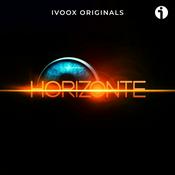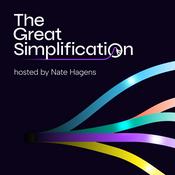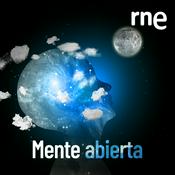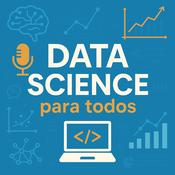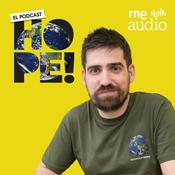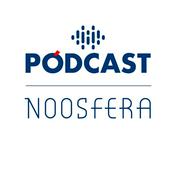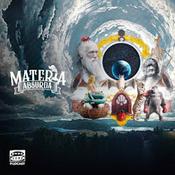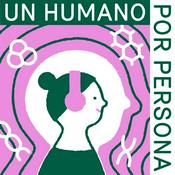93 episodios

Life Update and Farewell
14/5/2025 | 42 min
Hey guys! Sorry I've been MIA for so long. Hopefully this episode will give you a good sense of what I've been up to over the last year and what's next for me. I'm so proud of this project but I've decided it's time to say farewell. Listen to hear about my jobs, reflections on the podcast, and looking forward. Thank you for everything.

Dr. Amy Anderson Returns!
13/11/2024 | 1 h 7 min
Hello dear listeners! Thank you for your patience these past several months. As many of you may remember, Amy Anderson was the first ever guest on That Anthro Podcast, and she return today (4 years later) as Dr. Anderson. Amy did her PhD in Biological Anthropology at UC Santa Barbara, and is currently doing post-doctorate research at the Max Planck Institute. In this episode we cover how the pandemic shaped the last few years of her PhD research, her current research, as well as her new found hobby - foraging. We discuss applying to jobs and post-docs, the role of storytelling in knowledge production, and how we've changed since the first episode came out four years ago. I hope you enjoy this episode. Follow Amy on instagram @autobiography_of_red and @hiddencityforaging

Bioarchaeology: Ensuring a Future (episode 3 of 3)
08/5/2024 | 47 min
This is the third and final episode of the Bioarchaeology series. This episode tackles the question "why is bioarchaeology an important area of study?" The first part, featuring interviews with Dr. Haagen Klaus, Dr. Gwen Robbins Schug, and Dr. Jessica O'Reilly, regarding the applications of bioarchaeology to climate change research. The second part focuses on some of the changes necessary to further grow the field and better engage with the public. Finally, Dr. Jane Buikstra, Dr. Amy Anderson, and Dr. Gwen Robbins Schug, explain why they think bioarchaeology is an important area for future research. The cover art was designed and created by Jona Schlegel. Follow her on instragam @archaeoink or check out her website https://jonaschlegel.com/ References: Buikstra, J. E., DeWitte, S. N., Agarwal, S. C., Baker, B. J., Bartelink, E. J., Berger, E., … Zakrzewski, S. R. (2022). Twenty‐first century bioarchaeology: Taking stock and moving forward. American Journal of Biological Anthropology, 178(S74), 54–114. https://doi.org/10.1002/ajpa.24494 De la Cova, C. (2022). Ethical Considerations for Paleopathology. In The Routledge Handbook of Paleopathology (1st ed., pp. 381-396.) Routledge. https://doi.org/10.4324/9781003130994 Robbins Schug, G.. (2020). A Bioarchaeology of Climate and Environmental Change. In G. R. Schug (Ed.), The Routledge Handbook of the Bioarchaeology of Climate and Environmental Change (1st ed., pp. 1–16). Routledge. https://doi.org/10.4324/9781351030465-1 Robbins Schug, G., Buikstra, J. E., DeWitte, S. N., Baker, B. J., Berger, E., Buzon, M. R., … Zakrzewski, S. R. (2023). Climate change, human health, and resilience in the Holocene. Proceedings of the National Academy of Sciences, 120(4), e2209472120. https://doi.org/10.1073/pnas.2209472120

Bioarchaeology: Assessing the Present (episode 2 of 3)
08/5/2024 | 56 min
This is episode two of three in the Bioarchaeology, the past, present, and future series. This episode, Assessing the Present, builds off the previous episode's discussion on the methods bioarchaeologists use, and presents some of the newer, developing methods and technologies that are shaping current research in the field. This episode also dives into some of the important ethical considerations surrounding this type of research, and specifically discusses this as it relates to Native American groups and descendants. Additionally, this episode features interviews with several bioarchaeologists: Dr. Haagen Klaus, Dr. Amy Anderson, Dr. Gwen Robbins Schug, and PhD student Meg Hardie. The cover art was designed and created by Jona Schlegel. Follow her on instragam @archaeoink or check out her website https://jonaschlegel.com/ References: Agarwal, S. C. (2024). The bioethics of skeletal anatomy collections from India. Nature Communications, 15 (1), 1692. https://doi.org/10.1038/s41467-024-45738-6 Anderson, A. (2022). Skeletal indicators of early life stress: Insights into cribra orbitalia and porotic hyperostosis in a living subsistence population. Ph.D. dissertation, University of California, Santa Barbara. Anderson, A. S., Sutherland, M. L., O’Donnell, L., Hill, E. C., Hunt, D. R., Blackwell, A. D., & Gurven, M. D. (2021). Do computed tomography findings agree with traditional osteological examination? The case of porous cranial lesions. International Journal of Paleopathology, 33, 209–219. https://doi.org/10.1016/j.ijpp.2021.04.008 Boldsen, J. L., Milner, G. R., Konigsberg, L. W., and Wood, J. W. (2002). Transition analysis: A new method for estimating age from skeletons. In R. D. Hoppa and J. W. Vaupel (Eds.), Paleodemography (1st ed., pp. 73–106). Cambridge University Press. https://doi.org/10.1017/CBO9780511542428.005 Brooks, S., and Suchey, J. M. (1990). Skeletal age determination based on the os pubis: a comparison of the Acsádi-Nemeskéri and Suchey-Brooks methods. Human Evolution, 5, 227-238. Colwell, C. (2019). Plundered Skulls and Stolen Spirits: Inside the fight to reclaim native america's culture. University of Chicago Press. Rasmussen, M., Li, Y., Lindgreen, S. et al. (2010). Ancient human genome sequence of an extinct Palaeo-Eskimo. Nature. 463, 757–762. Robbins Schug, G., Killgrove, K., Atkin, A., & Baron, K. (2021). 3D Dead: Ethical Considerations in Digital Human Osteology. Bioarchaeology International, 4(3–4). https://doi.org/10.5744/bi.2020.3008 Schug, G. R. (2020). A Bioarchaeology of Climate and Environmental Change. In G. R. Schug (Ed.), The Routledge Handbook of the Bioarchaeology of Climate and Environmental Change (1st ed., pp. 1–16). Routledge. https://doi.org/10.4324/9781351030465-1 Stewart, N. A., Gerlach, R. F., Gowland, R. L., Gron, K. J., & Montgomery, J. (2017). Sex determination of human remains from peptides in tooth enamel. Proceedings of the National Academy of Sciences, 114(52), 13649–13654.

Bioarchaeology: Addressing the Past (episode 1 of 3)
08/5/2024 | 48 min
This is the first of three episodes in the Bioarchaeology, past, present, and future series. This series answers the question "what is bioarchaeology" in an understandable yet nuanced way. This episode, Addressing the Past, covers the basics of bioarchaeology, including how it differs from archaeology, basic methods used, and the history of physical anthropology. It also includes interviews with several prominent bioarchaeologists (Dr. Jane Buikstra, Dr, Clark Larsen, and Dr. Haagen Klaus) about their take on the development of this field of study. The cover art was designed and created by Jona Schlegel, follow her on instagram @archaeoink or check out her website https://jonaschlegel.com/ Follow @thatanthropodcast on Instagram References: Agarwal, S. C. (2024). The bioethics of skeletal anatomy collections from India. Nature Communications, 15(1), 1692. https://doi.org/10.1038/s41467-024-45738-6 Armelagos, G. J., & Cohen, M. N. (Eds.). (1984). Paleopathology at the Origins of Agriculture. Orlando, FL: Academic Press. Buikstra, J. E. (1977). Biocultural dimensions of archaeological study: a regional perspective. In Biocultural adaptation in prehistoric America, pp. 67-84. Cook, D. C. (2006). The old physical anthropology and the New World: a look at the accomplishments of an antiquated paradigm. In Buikstra, J. E., and Beck, L. A. (eds.) Bioarchaeology: The Contextual Analysis of Human Remains. Routledge. de la Cova, C. (2022). "Ethical issues and considerations for ethically engaging with the Robert J. Terry, Hamann-Todd, and William Montague Cobb anatomical collections." In American Journal of Biological Anthropology, vol. 177, pp. 42-42. Wiley. de la Cova, C. (2020a). Making silenced voices speak: Restoring neglected and ignored identities in anatomical collections. In C. M. Cheverko,J. R. Prince-Buitenhuys, & M. Hubbe (Eds.), Theoretical Perspectives in Bioarchaeology. Routledge, pp. 150–169. de la Cova, C. (2019). Marginalized bodies and the construction of the Robert J. Terry anatomical skeletal collection: a promised land lost. In Mant, M. and Holland, A. (eds.) Bioarchaeology of Marginalized People. Orlando: Academic Press, pp. 133-155. Larsen, C. (2015). Bioarchaeology: Interpreting Behavior from the Human Skeleton. Cambridge University Press. Morton, S. (1839). Crania Americana or a Comparative View of the Skulls of Various Aboriginal Nations of North and South America: To Which Is Prefixed an Essay on the Varieties of the Human Species; Illustrated by Seventy-Eight Plates and a Colored Map. Philadelphia: J. Dobson. Stienne, A. (2022). Mummified: The stories behind Egyptian mummies in museums, Manchester: Manchester University Press. van der Merwe NJ, Vogel JC. (1978). 13C content of human collagen as a measure of prehistoric diet in Woodland North America. Nature. 276: 815–816. Washburn, S. L. (1951). SECTION OF ANTHROPOLOGY: THE NEW PHYSICAL ANTHROPOLOGY. Transactions of the New York Academy of Sciences, 13(7 Series II), 298–304. https://doi.org/10.1111/j.2164-0947.1951.tb01033.x
Más podcasts de Ciencias
Podcasts a la moda de Ciencias
Acerca de That Anthro Podcast
Escucha That Anthro Podcast, Mindfacts: Historia y futuro de la Ciencia y la Tecnología y muchos más podcasts de todo el mundo con la aplicación de radio.es

Descarga la app gratuita: radio.es
- Añadir radios y podcasts a favoritos
- Transmisión por Wi-Fi y Bluetooth
- Carplay & Android Auto compatible
- Muchas otras funciones de la app
Descarga la app gratuita: radio.es
- Añadir radios y podcasts a favoritos
- Transmisión por Wi-Fi y Bluetooth
- Carplay & Android Auto compatible
- Muchas otras funciones de la app
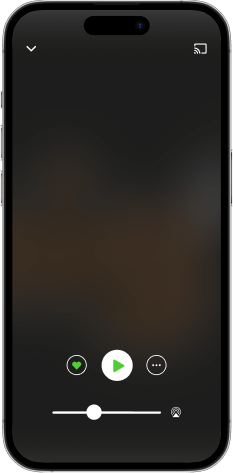

That Anthro Podcast
Descarga la app,
Escucha.







